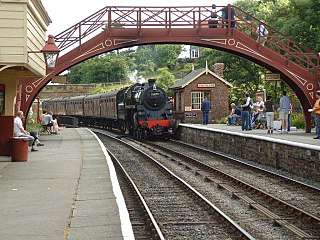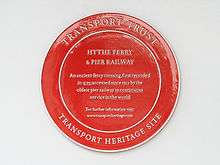Transport Trust
The Transport Trust is a British registered charity that aims to encourage the preservation of, and public interest in, artefacts and records of British transport history.[1]
The Trust seeks to act as a hub for the transport preservation movement, providing advice and assistance, organising public events, and working to secure suitable accommodation and maintenance facilities for historic items. The Trust was founded in 1965.
Objectives
The Trust is a registered charity that supports restoration campaigns and projects.
The Trust also offers legal and technical advice to conservation groups and bodies such as Heritage Link, the Heritage Lottery Fund and the UK Government. It presents annual restoration awards [2] and has a particular mission to encourage young people to take part in restoration projects. The Trust's Patron is Prince Michael of Kent.
Pressures on heritage preservation
The Heritage Lottery Fund commissioned the Transport Trust to assess pressures on the transport heritage movement, and the state of artefacts and locations to help them prioritise applications for funding support. The resulting 145 page report,[3] Transport Heritage: An Assessment of Needs & Potential', provides a unique snapshot of the health of the transport preservation movement in Britain. The movement is important, touching people at many levels and has a wide appeal - it is estimated that audiences and participants in heritage transport activities exceed 15 million people a year, making it one of Britain's most important leisure activities. Britain's particularly rich transport history has no doubt played a catalytic role to build up this level of grass roots participation.
Surprisingly, although there are good collections of artefacts in public sector museums, it is the private sector preservationists that have made the most significant contribution to conservation and to the provision of the active enjoyment of transport by the public. A supreme example is the restoration to flight status of Avro Vulcan XH558, which represents the most complex restoration project ever undertaken globally, was funded entirely by public donations and for which the Chief Executive of the Vulcan To The Sky Trust, Dr Robert Pleming, was presented the Transport Trust Preservationist of The Year award by Prince Michael of Kent.
The key conclusions for each major transport area were:
Aviation
The widespread preservation of aircraft in the UK began in the 1960s when a large number of obsolete military aircraft became available. A push to co-ordinate the movement led to founding of the British Aviation Preservation Council (BAPC) in 1967, but very few private collections are represented. Although over 2,500 aircraft survive and are capable of preservation, little progress has been made to develop a clear preservation strategy, with 4% of the highest graded and as many as 26% of the second kept outside. Historically, insufficient attention has also been paid to preserving airfield architecture, although the designation in 2007 of Duxford Aerodrome as a Conservation Area will help preserve a virtually intact site, first established as a Royal Flying Corps base in 1916 and fully operational as an RAF base until 1961. This Battle of Britain airfield, home to Douglas Bader's Big Wing experiments and the first RAF base to receive the Supermarine Spitfire, now houses the Imperial War Museum Duxford, the largest centre of European aviation history and home to the largest collection of American aircraft outside of the US.
The key needs for the aviation category are to prioritise individual aircraft for preservation; to move middle grade airframes into hangarage; to pay greater attention to civil aircraft; to deal with pressing gaps in conservation skills.
Buses and coaches
There are about 4,000 buses and coaches in preservation of which some 45% are in a recognised collection or museum, private or public, but less than 30% are restored. Most in museums are from the 1950s and 1960s, with only 10% from before 1940, but over 80% of the total are owned by private individuals - with little support they have been responsible for the majority of bus conservation. Little progress has been made in prioritising this assortment, which is scattered all over the country, with some concentration in the cities.
The key needs for the bus and coach category are the completion of a category register of preserved buses as a prelude to introducing a grading system; a strategy for accommodating at least the most important vehicles under cover (presently 50% of all preserved buses are stored in the open); the conservation of the most important vehicles; facilities for improved public access and education; an archive of papers, ephemera and small artefacts which might otherwise disappear.
Railways

With over 400 miles of track, nearly 600 stations and about 150 locations around the country, heritage railways and the items in museums represent a big investment. Amassing a combined annual turnover in excess of £30 million and around 9 million passengers a year, they form a prime element of the British leisure industry. Incredibly, over 1,000 steam engines survive, though less than 20% are operable at any one time due to the high cost of overhaul. In addition, over 700 diesel locomotives and about 150 passenger units are in preservation together with a regrettably small number of electric units. Over 3,000 passenger carriages and 2,500 freight vehicles are also held in various states of conservation. The Heritage Railway Association provides support and advice to heritage lines. The busiest heritage line in Britain is the North Yorkshire Moors Railway, which operates over 100 days a year over the bulk of the 24 mile trackbed constructed by George Stephenson and which opened in 1836.
The key needs for the railways category are a grading system for vehicles and lines to focus funding on the most worthy; safe access for the public to workshops and sheds to increase visitor appeal; covered accommodation for both restoration work and carriage storage; a concerted effort to conserve electric trains; support for private enthusiast restoration projects to increase capacity; archive storage to minimise losses of priceless records.
Maritime
This diverse and scattered category is highly dependent on private individuals. Only canal and inland waterways craft have a degree of structure, largely because of their links with the waterways. Others such as fishing boats, lifeboats and traditional river craft are found all round the UK. In museums smaller vessels are typically overshadowed by larger ones. Steam has a strong following. Most boats are privately owned and the majority are sailable. There are probably about 500 small boats of major historical importance which should be preserved - their interests are managed by a plethora of ‘umbrella’ organisations, to which the National Maritime Museum is attempting to bring a degree of co-ordination. The National Small Boat Register, managed by the National Maritime Museum Cornwall, maintains listings of over 1,200 small craft (under 12m/40 ft) that embrace rarity, historic and cultural value. The Advisory Committee for National Historic Ships maintains a register of larger historic vessels [over 10.1m/33 ft] that have demonstrably strong UK associations.
The key needs for the maritime category are a common grading system across the category is needed in order to prioritise conservation efforts; the preservation of the 500 small craft of significant heritage importance could be enhanced by relatively modest supporting sums; more training in traditional skills; safe storage where boats at risk could be placed pending restoration.
General conclusions

Despite the rich diversity of Britain's transport heritage, there are many common threads. Strategic leadership and vision is vital and umbrella organisations can play a vital role. Undercover storage is also critical for artefacts that have long exceeded their envisaged working lives. And, finally, since transport is appreciated most when used, many irreplaceable historical relics are wearing out and should be replaced by working replicas.
Red Wheel programme
The Trust runs a scheme that creates and places Red Wheel transport heritage plaques on especially important and unusual sites of transport heritage. The Trust is open to nominations for Red Wheel plaques at sites which would otherwise be ignored or their value under appreciated by members of the public.[4]
References
- "Transport Trust - welcome". www.transporttrust.com.
- "Awards". www.transporttrust.com.
- Heritage Lottery Fund. "Transport Heritage: An Assessment of Needs and Potential" (PDF). Archived from the original (PDF) on 10 June 2008. Retrieved 21 April 2013.
- "Nominate Red Wheel Site". www.transporttrust.com.